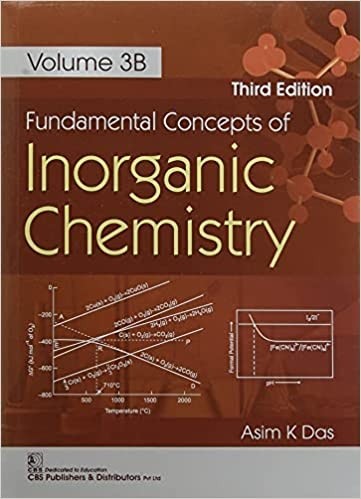Fundamental Concepts Of Inorganic Chemistry Vol 3B 3Ed (Pb 2021)
Asim K Das BSc (1st Class 1st, CU), MSc (Gold Medalist, CU), PhD (CU), DSc (Visva Bharati) is currently Professor, Department of Chemistry, Visva Bharati University, Santiniketan, West Bengal. He has over 30 years of teaching experience at both undergraduate and postgraduate levels. He passed both BSc (Hons in Chemistry) in 1981 and MSc (specialization in Inorganic Chemistry) in 1983, standing First Class First, from the University of Calcutta. He received his PhD degree from the same university under the supervision of Prof D Banerjea, the then Sir Rashbehari Ghose Professor of Chemistry. He received his DSc degree from Visva Bharati in 2002. Dr Das has published more than 80 research papers in the field of thermodynamic and kinetic aspects of metal complexes in reputed national and international journals. He has written the books, Bioinorganic Chemistry; Environmental Chemistry with Green Chemistry; Biophysical, Bioorganic and Bioinorganic Chemistry; An Introduction to Nanomaterials and Nanoscience and An Introduction to Supramolecular Chemistry. ... Read more Read less
Volume 1: Atomic Structure; Wave Mechanics and Quantum Chemistry, Nuclear Structure; Nuclear Chemistry, Nuclear Reactions and Nuclear Energy; Radiation Chemistry; Nucleosynthesis of Elements; Chemical Periodicity of the Elements.
Volume 2: Bonding Theories (VBT and MOT) of Covalency; Structure and Reactivity of Covalent Compounds; Stereochemical Nonrigidity and Fluxionality; Molecular Symmetry and Point Groups Hydrogen Bonding and other Weak Chemical Forces; Supramolecular Systems and Molecular Recognitions.
Volume 3A: Solid State Chemistry-Structure and Bonding; Magnetic and Ferroelectric Materials; Bonding in Metals and Metal Clusters; PSPT-Wade's Rule and Jemmi's Rule; Electrical Conductivities of Solids; Semiconductors and Superconductors; Acids and Bases and lonic Equilibria.
Volume 3B: Nonaqueous Solvents and Ionic Liquids; Redox Potentials, Formal Potentials and Applications; EMF Diagrams; Electroanalytical Techniques; Photoredox Reactions; Oscillating Reactions; Principles of Metallurgy and Refining and Purification of Metals; Different Techniques of Separation-Solvent Extraction, Ion Exchange and Chromatography.
Volume 4: Coordination Chemistry: Introduction, Structure, Stereochemistry and Isomerism, Nomenclature, Bonding Theories (VBT, CFT, LFT and MOT), Applications of CFT, JT Distortion, Spectrochemical Series, and Stabilities of Metal Complexes.
Volume 5: Coordination Chemistry: Inorganic Reaction Mechanisms (Ligand Substitution, Isomerisation, Racemisation, Electron Transfer and Photochemical Reactions), Electronic Spectra of Metal Complexes.
Volume 6: Coordination Chemistry: Magnetochemistry and Magnetic Properties of Metal Complexes; Structure, Bonding and Reactivities of Organometallics including Metal Carbonyls and Nitrosyls; Organometallics as Catalysts.
Volume 7: Application of Metal Complexes in Analytical Chemistry and other Fields; Applications of Spectrophotometric Methods (IR, Raman, NMR, ESR, Mossbauer, UV-VIS, UV-PES); Theory of Errors and Statistical Treatment of Data.
... Read more Read less










